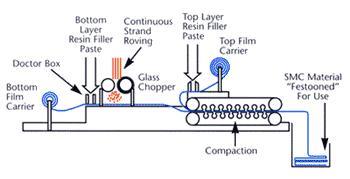Definition: A glass fiber reinforced thermosetting compound in sheet form, usually wound on reels interspersed with plastic film to prevent self-adhesion.
Made by dispensing mixed resin, fillers, maturing agent, catalyst and release agent onto two movable sheets of polyethylene film. The lower one also contains chopped glass or fiberglass roving. SMC can be molded into complex shapes with little waste.

Sheet molding compound (SMC) is a glass fiber reinforced composite material produced in a “sheet” shape.
The process begins when continuous fiberglass (also called “roving”) is cut into the desired lengths. The fabrics are deposited on a bottom layer of paste made from resin and filler. The paste and fiberglass fabric pass through the processing machine on a carrier film. A top layer of resin and filler paste joins the fibers to the bottom layer of paste and is covered by a top layer of carrier film. The “fiber and paste sandwich” is then compacted by a series of rollers to make a continuous sheet of molding dough.
SMC is made of 3 basic components: the base resin system, reinforcements (fiberglass, graphite, aramid) and additives that include inert fillers, pigments, UV stabilizers, catalysts, inhibitors, and thickeners.
Although there is basically no limit to the number and types of formulations that can be produced, it is important to prioritize the desired properties of the product. This helps ensure that the ideal material system is achieved within the program's economic guidelines.
Compression Molding:

Compression molding primarily uses thermosetting composite resin systems, which use heat to permanently form and define the shape of a part. Once the resin has cured, the piece cannot be reformed, making the process irreversible.
Compression molding uses combined steel molds to compress a heavy "load" of sheet molding compound (SMC) into a new, specific shape. The two halves of the mold, which are assembled in a hydraulic molding press, are closed around the load. The combination of heat (300 degrees) and pressure (1000 PSI) caused the thermoset material to cure in the mold. Molding cycles range from less than 1 minute to more than 5 minutes, depending on the size and cross-sectional thickness of the part. The mold is then opened and the part removed.




